International Marketing for Travel and Tourism: Malmaison Hotel Report
VerifiedAdded on 2020/05/04
|31
|7331
|31
Report
AI Summary
This report provides a comprehensive analysis of Malmaison Hotel's international marketing strategies. It begins with an introduction to the hotel group and its brand promise, followed by a detailed situational analysis, including macro and micro environmental factors. The macro analysis utilizes PESTLE analysis to evaluate political, economic, social/cultural, technological, legal, and environmental factors impacting the hotel. Microanalysis employs Porter's Five Forces to assess competitive rivalry, supplier power, buyer power, the threat of new entrants, and substitute products. Internal and external environment analyses are conducted using the McKinsey 7-S model and SWOT analysis, identifying strengths, weaknesses, opportunities, and threats. The report then explores Malmaison's international marketing practices, including market selection, entry modes, segmentation, targeting, and positioning. It evaluates the cost-effectiveness of sales promotion, addresses issues affecting the overall strategy, and provides recommendations for product, price, promotion, people, place, process, and physical evidence. Risk assessment and a conclusion summarize the key findings and recommendations. The report is a valuable resource for understanding international marketing in the travel and tourism sector.
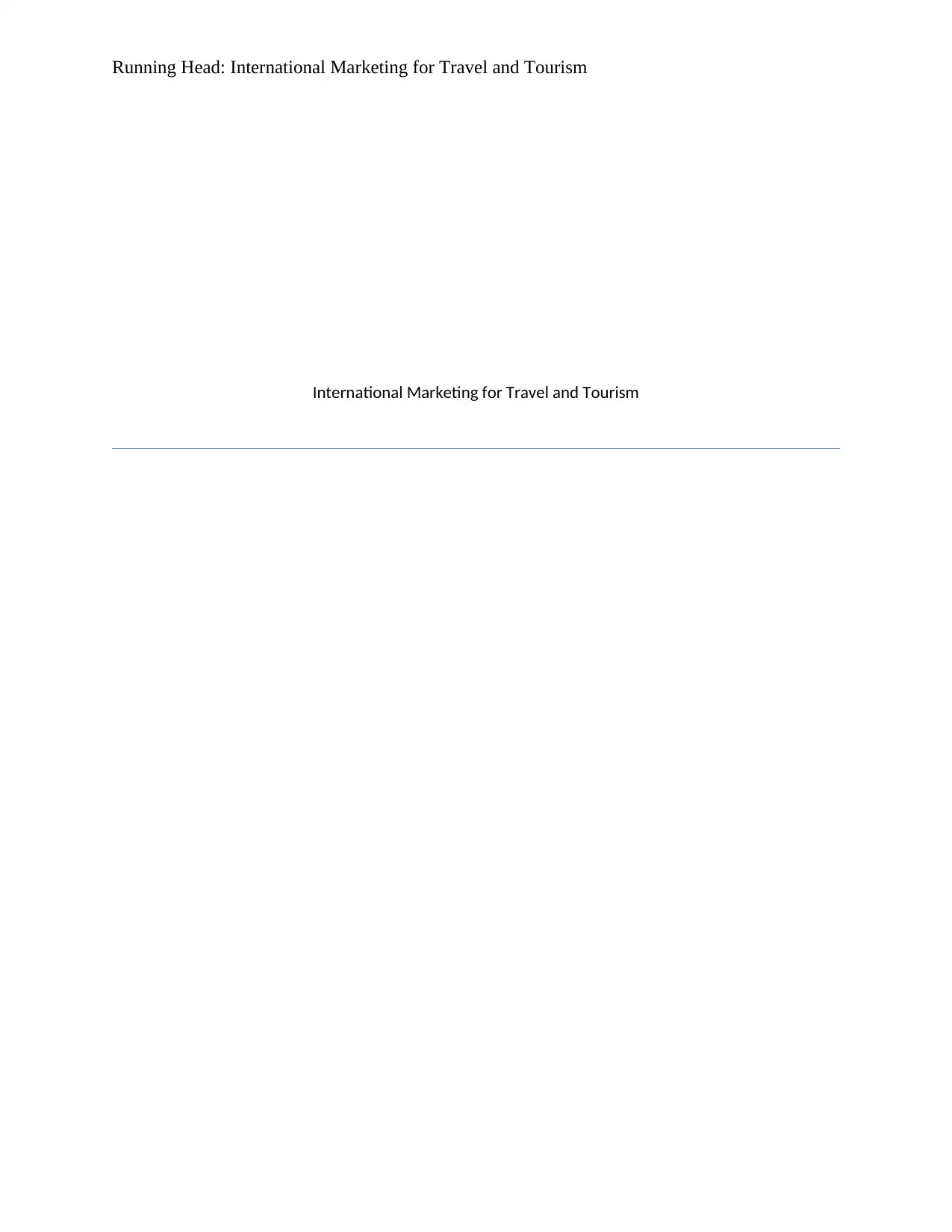
Running Head: International Marketing for Travel and Tourism
International Marketing for Travel and Tourism
International Marketing for Travel and Tourism
Paraphrase This Document
Need a fresh take? Get an instant paraphrase of this document with our AI Paraphraser
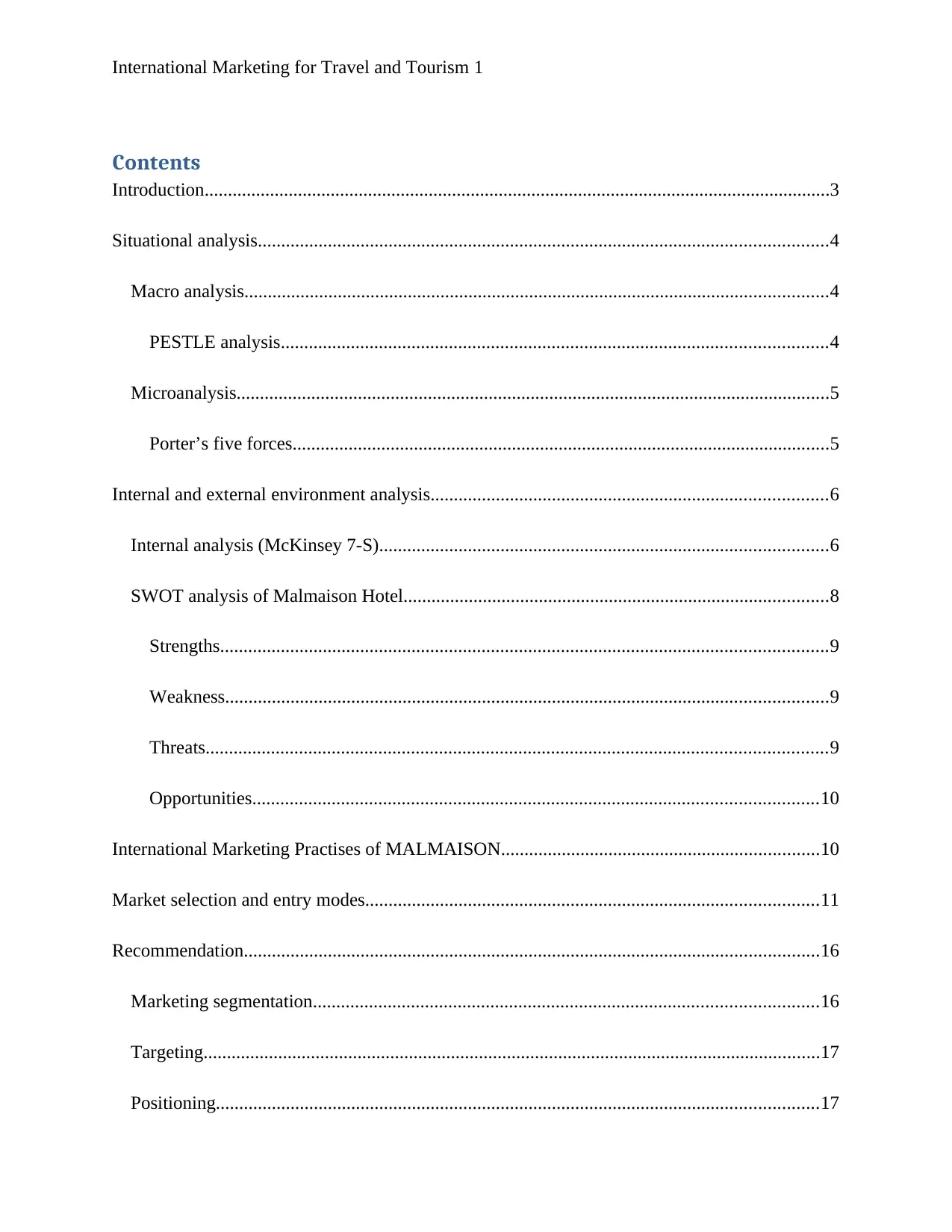
International Marketing for Travel and Tourism 1
Contents
Introduction......................................................................................................................................3
Situational analysis..........................................................................................................................4
Macro analysis.............................................................................................................................4
PESTLE analysis.....................................................................................................................4
Microanalysis...............................................................................................................................5
Porter’s five forces...................................................................................................................5
Internal and external environment analysis.....................................................................................6
Internal analysis (McKinsey 7-S)................................................................................................6
SWOT analysis of Malmaison Hotel...........................................................................................8
Strengths..................................................................................................................................9
Weakness.................................................................................................................................9
Threats.....................................................................................................................................9
Opportunities.........................................................................................................................10
International Marketing Practises of MALMAISON....................................................................10
Market selection and entry modes.................................................................................................11
Recommendation...........................................................................................................................16
Marketing segmentation............................................................................................................16
Targeting....................................................................................................................................17
Positioning.................................................................................................................................17
Contents
Introduction......................................................................................................................................3
Situational analysis..........................................................................................................................4
Macro analysis.............................................................................................................................4
PESTLE analysis.....................................................................................................................4
Microanalysis...............................................................................................................................5
Porter’s five forces...................................................................................................................5
Internal and external environment analysis.....................................................................................6
Internal analysis (McKinsey 7-S)................................................................................................6
SWOT analysis of Malmaison Hotel...........................................................................................8
Strengths..................................................................................................................................9
Weakness.................................................................................................................................9
Threats.....................................................................................................................................9
Opportunities.........................................................................................................................10
International Marketing Practises of MALMAISON....................................................................10
Market selection and entry modes.................................................................................................11
Recommendation...........................................................................................................................16
Marketing segmentation............................................................................................................16
Targeting....................................................................................................................................17
Positioning.................................................................................................................................17
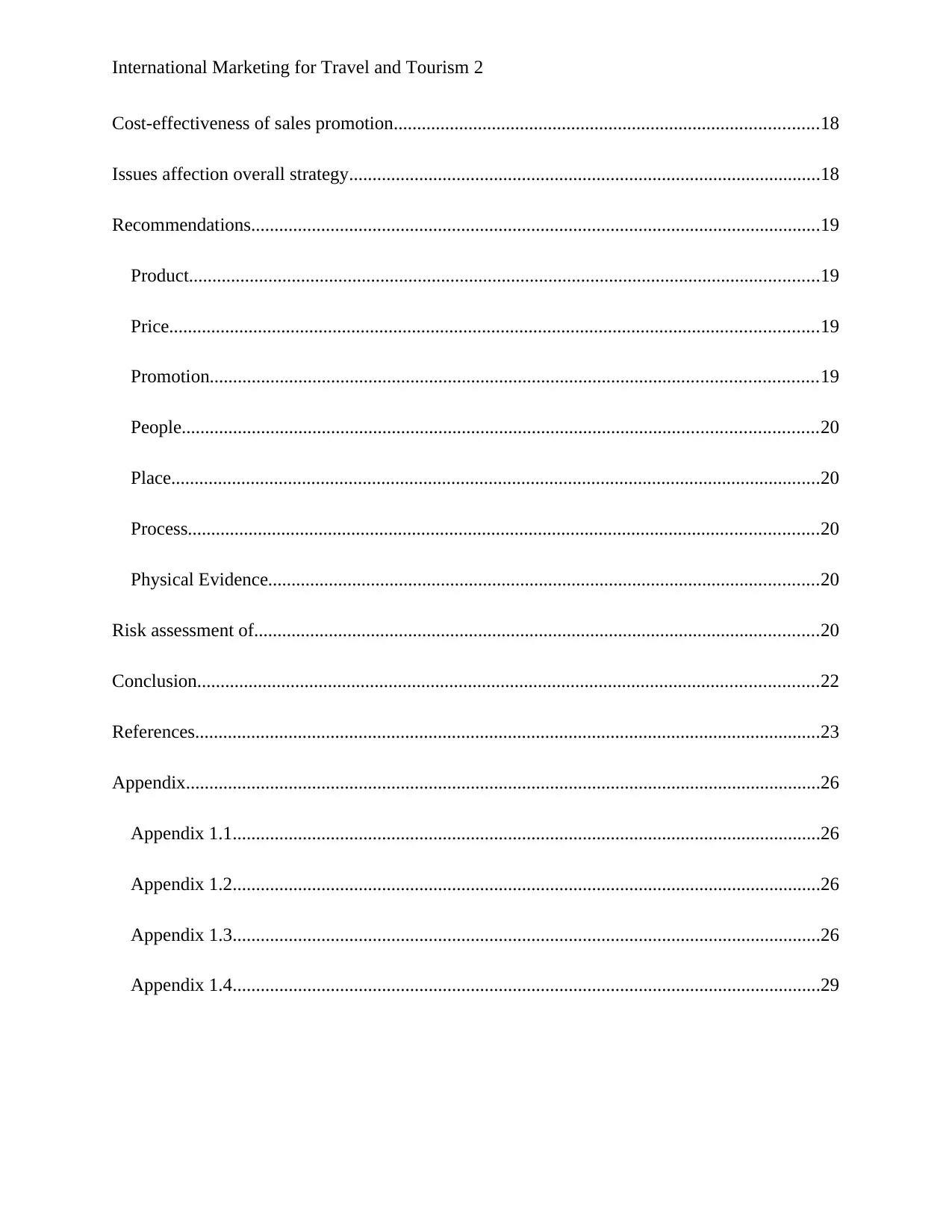
International Marketing for Travel and Tourism 2
Cost-effectiveness of sales promotion...........................................................................................18
Issues affection overall strategy.....................................................................................................18
Recommendations..........................................................................................................................19
Product.......................................................................................................................................19
Price...........................................................................................................................................19
Promotion..................................................................................................................................19
People........................................................................................................................................20
Place...........................................................................................................................................20
Process.......................................................................................................................................20
Physical Evidence......................................................................................................................20
Risk assessment of.........................................................................................................................20
Conclusion.....................................................................................................................................22
References......................................................................................................................................23
Appendix........................................................................................................................................26
Appendix 1.1..............................................................................................................................26
Appendix 1.2..............................................................................................................................26
Appendix 1.3..............................................................................................................................26
Appendix 1.4..............................................................................................................................29
Cost-effectiveness of sales promotion...........................................................................................18
Issues affection overall strategy.....................................................................................................18
Recommendations..........................................................................................................................19
Product.......................................................................................................................................19
Price...........................................................................................................................................19
Promotion..................................................................................................................................19
People........................................................................................................................................20
Place...........................................................................................................................................20
Process.......................................................................................................................................20
Physical Evidence......................................................................................................................20
Risk assessment of.........................................................................................................................20
Conclusion.....................................................................................................................................22
References......................................................................................................................................23
Appendix........................................................................................................................................26
Appendix 1.1..............................................................................................................................26
Appendix 1.2..............................................................................................................................26
Appendix 1.3..............................................................................................................................26
Appendix 1.4..............................................................................................................................29
⊘ This is a preview!⊘
Do you want full access?
Subscribe today to unlock all pages.

Trusted by 1+ million students worldwide
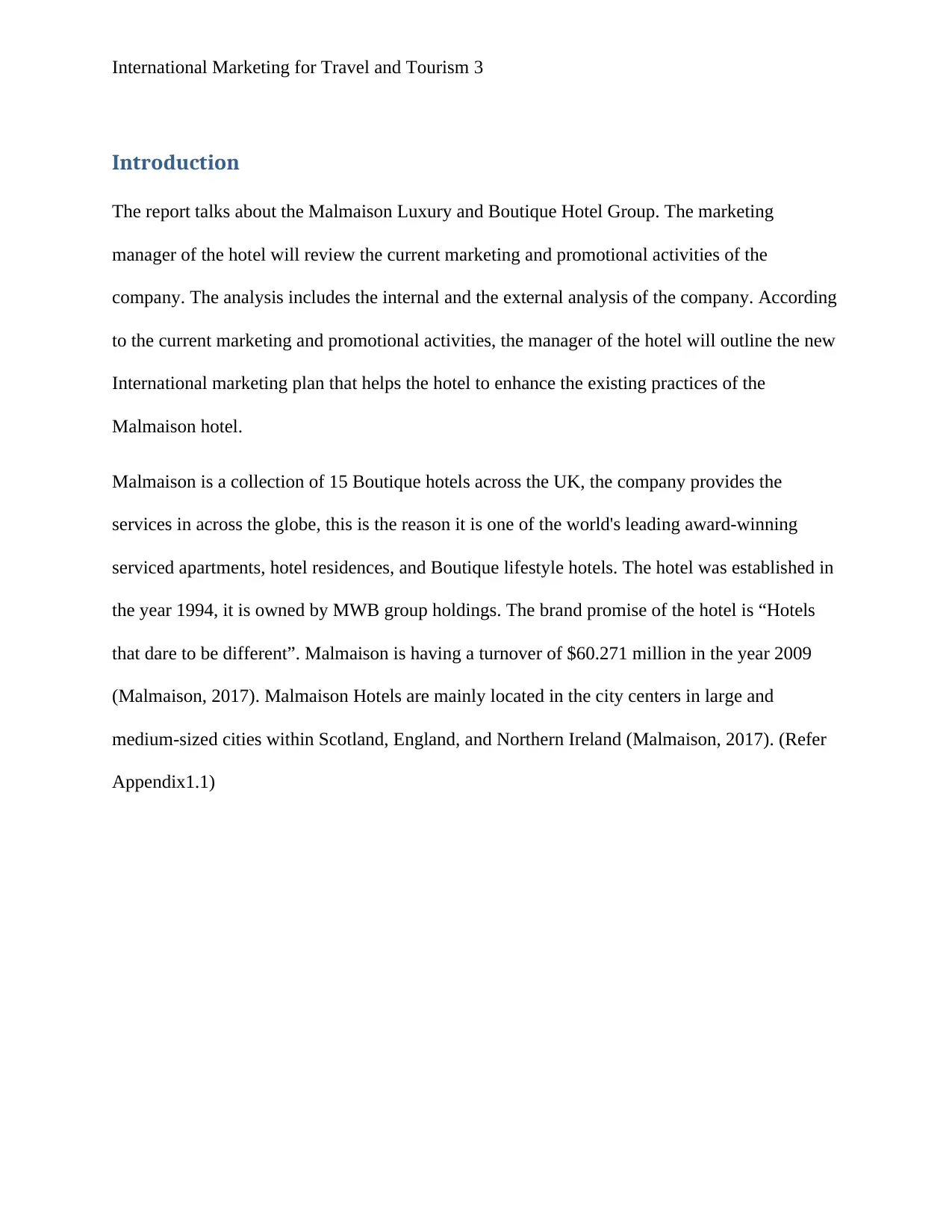
International Marketing for Travel and Tourism 3
Introduction
The report talks about the Malmaison Luxury and Boutique Hotel Group. The marketing
manager of the hotel will review the current marketing and promotional activities of the
company. The analysis includes the internal and the external analysis of the company. According
to the current marketing and promotional activities, the manager of the hotel will outline the new
International marketing plan that helps the hotel to enhance the existing practices of the
Malmaison hotel.
Malmaison is a collection of 15 Boutique hotels across the UK, the company provides the
services in across the globe, this is the reason it is one of the world's leading award-winning
serviced apartments, hotel residences, and Boutique lifestyle hotels. The hotel was established in
the year 1994, it is owned by MWB group holdings. The brand promise of the hotel is “Hotels
that dare to be different”. Malmaison is having a turnover of $60.271 million in the year 2009
(Malmaison, 2017). Malmaison Hotels are mainly located in the city centers in large and
medium-sized cities within Scotland, England, and Northern Ireland (Malmaison, 2017). (Refer
Appendix1.1)
Introduction
The report talks about the Malmaison Luxury and Boutique Hotel Group. The marketing
manager of the hotel will review the current marketing and promotional activities of the
company. The analysis includes the internal and the external analysis of the company. According
to the current marketing and promotional activities, the manager of the hotel will outline the new
International marketing plan that helps the hotel to enhance the existing practices of the
Malmaison hotel.
Malmaison is a collection of 15 Boutique hotels across the UK, the company provides the
services in across the globe, this is the reason it is one of the world's leading award-winning
serviced apartments, hotel residences, and Boutique lifestyle hotels. The hotel was established in
the year 1994, it is owned by MWB group holdings. The brand promise of the hotel is “Hotels
that dare to be different”. Malmaison is having a turnover of $60.271 million in the year 2009
(Malmaison, 2017). Malmaison Hotels are mainly located in the city centers in large and
medium-sized cities within Scotland, England, and Northern Ireland (Malmaison, 2017). (Refer
Appendix1.1)
Paraphrase This Document
Need a fresh take? Get an instant paraphrase of this document with our AI Paraphraser
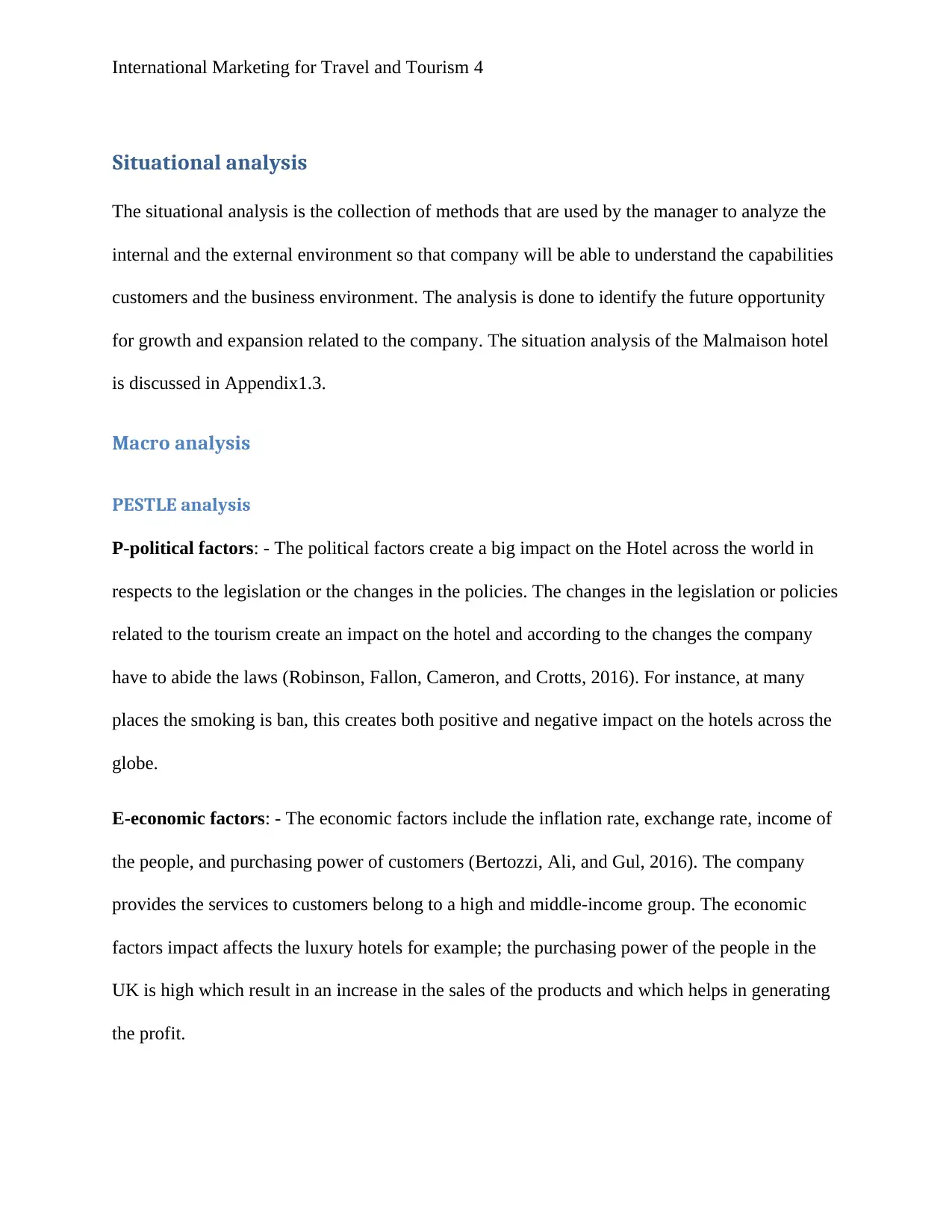
International Marketing for Travel and Tourism 4
Situational analysis
The situational analysis is the collection of methods that are used by the manager to analyze the
internal and the external environment so that company will be able to understand the capabilities
customers and the business environment. The analysis is done to identify the future opportunity
for growth and expansion related to the company. The situation analysis of the Malmaison hotel
is discussed in Appendix1.3.
Macro analysis
PESTLE analysis
P-political factors: - The political factors create a big impact on the Hotel across the world in
respects to the legislation or the changes in the policies. The changes in the legislation or policies
related to the tourism create an impact on the hotel and according to the changes the company
have to abide the laws (Robinson, Fallon, Cameron, and Crotts, 2016). For instance, at many
places the smoking is ban, this creates both positive and negative impact on the hotels across the
globe.
E-economic factors: - The economic factors include the inflation rate, exchange rate, income of
the people, and purchasing power of customers (Bertozzi, Ali, and Gul, 2016). The company
provides the services to customers belong to a high and middle-income group. The economic
factors impact affects the luxury hotels for example; the purchasing power of the people in the
UK is high which result in an increase in the sales of the products and which helps in generating
the profit.
Situational analysis
The situational analysis is the collection of methods that are used by the manager to analyze the
internal and the external environment so that company will be able to understand the capabilities
customers and the business environment. The analysis is done to identify the future opportunity
for growth and expansion related to the company. The situation analysis of the Malmaison hotel
is discussed in Appendix1.3.
Macro analysis
PESTLE analysis
P-political factors: - The political factors create a big impact on the Hotel across the world in
respects to the legislation or the changes in the policies. The changes in the legislation or policies
related to the tourism create an impact on the hotel and according to the changes the company
have to abide the laws (Robinson, Fallon, Cameron, and Crotts, 2016). For instance, at many
places the smoking is ban, this creates both positive and negative impact on the hotels across the
globe.
E-economic factors: - The economic factors include the inflation rate, exchange rate, income of
the people, and purchasing power of customers (Bertozzi, Ali, and Gul, 2016). The company
provides the services to customers belong to a high and middle-income group. The economic
factors impact affects the luxury hotels for example; the purchasing power of the people in the
UK is high which result in an increase in the sales of the products and which helps in generating
the profit.
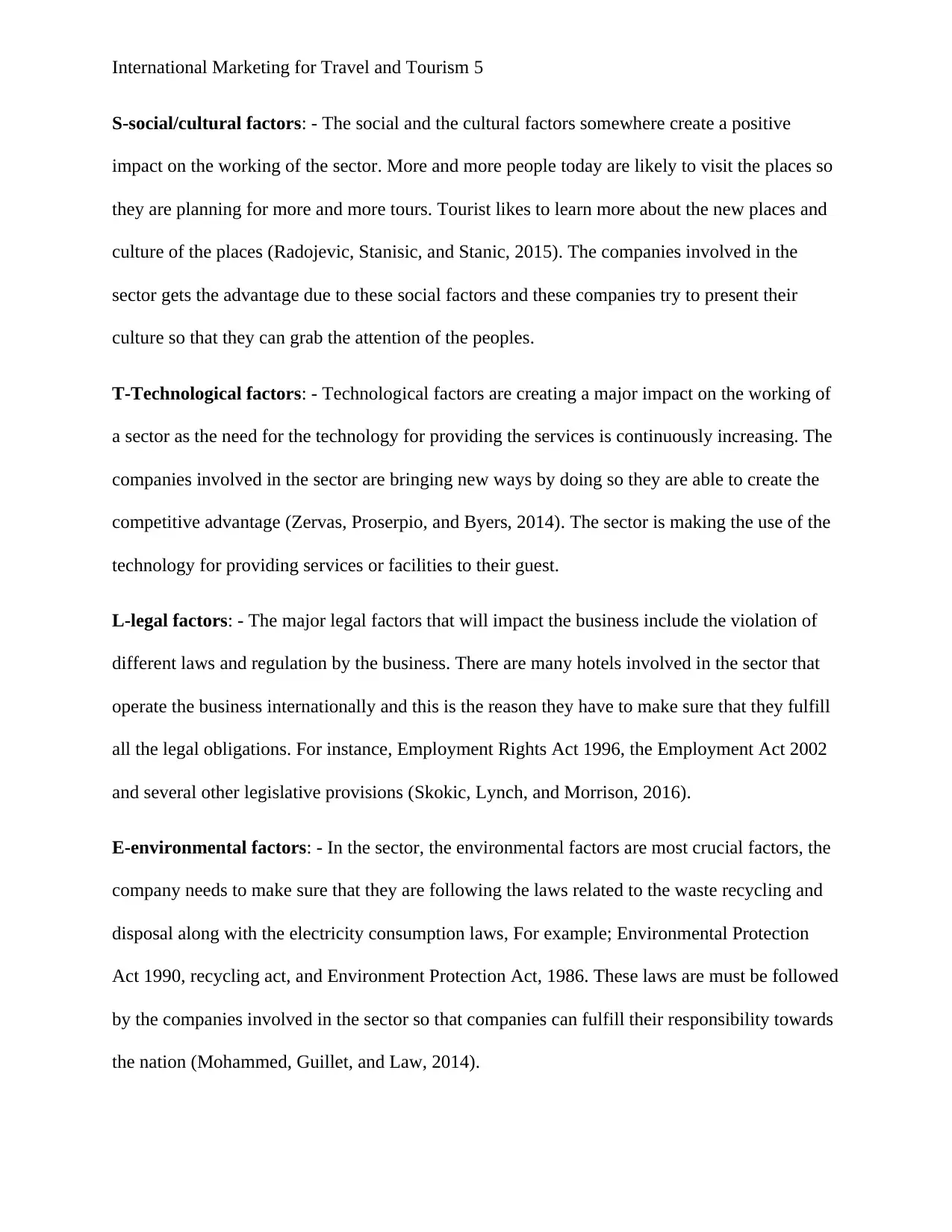
International Marketing for Travel and Tourism 5
S-social/cultural factors: - The social and the cultural factors somewhere create a positive
impact on the working of the sector. More and more people today are likely to visit the places so
they are planning for more and more tours. Tourist likes to learn more about the new places and
culture of the places (Radojevic, Stanisic, and Stanic, 2015). The companies involved in the
sector gets the advantage due to these social factors and these companies try to present their
culture so that they can grab the attention of the peoples.
T-Technological factors: - Technological factors are creating a major impact on the working of
a sector as the need for the technology for providing the services is continuously increasing. The
companies involved in the sector are bringing new ways by doing so they are able to create the
competitive advantage (Zervas, Proserpio, and Byers, 2014). The sector is making the use of the
technology for providing services or facilities to their guest.
L-legal factors: - The major legal factors that will impact the business include the violation of
different laws and regulation by the business. There are many hotels involved in the sector that
operate the business internationally and this is the reason they have to make sure that they fulfill
all the legal obligations. For instance, Employment Rights Act 1996, the Employment Act 2002
and several other legislative provisions (Skokic, Lynch, and Morrison, 2016).
E-environmental factors: - In the sector, the environmental factors are most crucial factors, the
company needs to make sure that they are following the laws related to the waste recycling and
disposal along with the electricity consumption laws, For example; Environmental Protection
Act 1990, recycling act, and Environment Protection Act, 1986. These laws are must be followed
by the companies involved in the sector so that companies can fulfill their responsibility towards
the nation (Mohammed, Guillet, and Law, 2014).
S-social/cultural factors: - The social and the cultural factors somewhere create a positive
impact on the working of the sector. More and more people today are likely to visit the places so
they are planning for more and more tours. Tourist likes to learn more about the new places and
culture of the places (Radojevic, Stanisic, and Stanic, 2015). The companies involved in the
sector gets the advantage due to these social factors and these companies try to present their
culture so that they can grab the attention of the peoples.
T-Technological factors: - Technological factors are creating a major impact on the working of
a sector as the need for the technology for providing the services is continuously increasing. The
companies involved in the sector are bringing new ways by doing so they are able to create the
competitive advantage (Zervas, Proserpio, and Byers, 2014). The sector is making the use of the
technology for providing services or facilities to their guest.
L-legal factors: - The major legal factors that will impact the business include the violation of
different laws and regulation by the business. There are many hotels involved in the sector that
operate the business internationally and this is the reason they have to make sure that they fulfill
all the legal obligations. For instance, Employment Rights Act 1996, the Employment Act 2002
and several other legislative provisions (Skokic, Lynch, and Morrison, 2016).
E-environmental factors: - In the sector, the environmental factors are most crucial factors, the
company needs to make sure that they are following the laws related to the waste recycling and
disposal along with the electricity consumption laws, For example; Environmental Protection
Act 1990, recycling act, and Environment Protection Act, 1986. These laws are must be followed
by the companies involved in the sector so that companies can fulfill their responsibility towards
the nation (Mohammed, Guillet, and Law, 2014).
⊘ This is a preview!⊘
Do you want full access?
Subscribe today to unlock all pages.

Trusted by 1+ million students worldwide
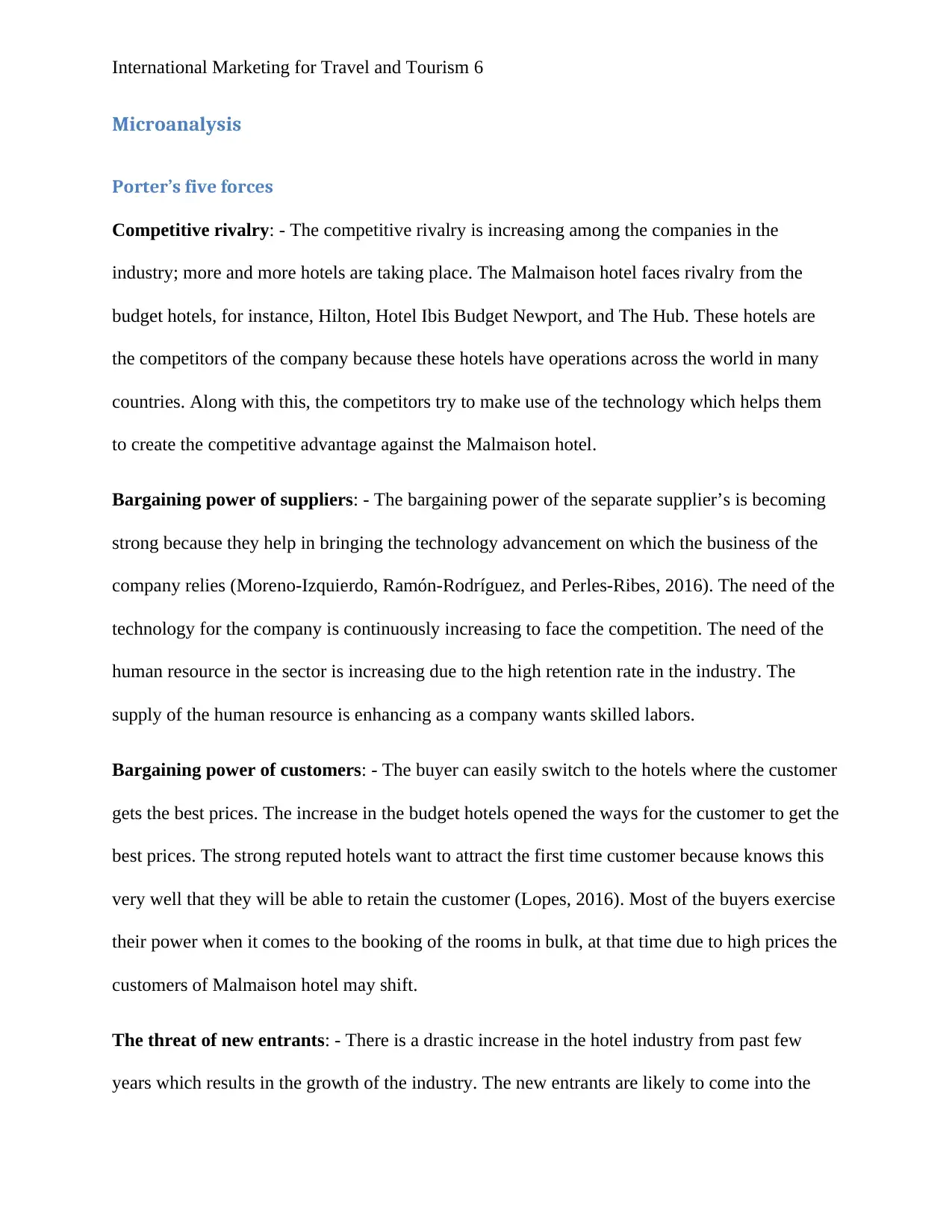
International Marketing for Travel and Tourism 6
Microanalysis
Porter’s five forces
Competitive rivalry: - The competitive rivalry is increasing among the companies in the
industry; more and more hotels are taking place. The Malmaison hotel faces rivalry from the
budget hotels, for instance, Hilton, Hotel Ibis Budget Newport, and The Hub. These hotels are
the competitors of the company because these hotels have operations across the world in many
countries. Along with this, the competitors try to make use of the technology which helps them
to create the competitive advantage against the Malmaison hotel.
Bargaining power of suppliers: - The bargaining power of the separate supplier’s is becoming
strong because they help in bringing the technology advancement on which the business of the
company relies (Moreno-Izquierdo, Ramón-Rodríguez, and Perles-Ribes, 2016). The need of the
technology for the company is continuously increasing to face the competition. The need of the
human resource in the sector is increasing due to the high retention rate in the industry. The
supply of the human resource is enhancing as a company wants skilled labors.
Bargaining power of customers: - The buyer can easily switch to the hotels where the customer
gets the best prices. The increase in the budget hotels opened the ways for the customer to get the
best prices. The strong reputed hotels want to attract the first time customer because knows this
very well that they will be able to retain the customer (Lopes, 2016). Most of the buyers exercise
their power when it comes to the booking of the rooms in bulk, at that time due to high prices the
customers of Malmaison hotel may shift.
The threat of new entrants: - There is a drastic increase in the hotel industry from past few
years which results in the growth of the industry. The new entrants are likely to come into the
Microanalysis
Porter’s five forces
Competitive rivalry: - The competitive rivalry is increasing among the companies in the
industry; more and more hotels are taking place. The Malmaison hotel faces rivalry from the
budget hotels, for instance, Hilton, Hotel Ibis Budget Newport, and The Hub. These hotels are
the competitors of the company because these hotels have operations across the world in many
countries. Along with this, the competitors try to make use of the technology which helps them
to create the competitive advantage against the Malmaison hotel.
Bargaining power of suppliers: - The bargaining power of the separate supplier’s is becoming
strong because they help in bringing the technology advancement on which the business of the
company relies (Moreno-Izquierdo, Ramón-Rodríguez, and Perles-Ribes, 2016). The need of the
technology for the company is continuously increasing to face the competition. The need of the
human resource in the sector is increasing due to the high retention rate in the industry. The
supply of the human resource is enhancing as a company wants skilled labors.
Bargaining power of customers: - The buyer can easily switch to the hotels where the customer
gets the best prices. The increase in the budget hotels opened the ways for the customer to get the
best prices. The strong reputed hotels want to attract the first time customer because knows this
very well that they will be able to retain the customer (Lopes, 2016). Most of the buyers exercise
their power when it comes to the booking of the rooms in bulk, at that time due to high prices the
customers of Malmaison hotel may shift.
The threat of new entrants: - There is a drastic increase in the hotel industry from past few
years which results in the growth of the industry. The new entrants are likely to come into the
Paraphrase This Document
Need a fresh take? Get an instant paraphrase of this document with our AI Paraphraser
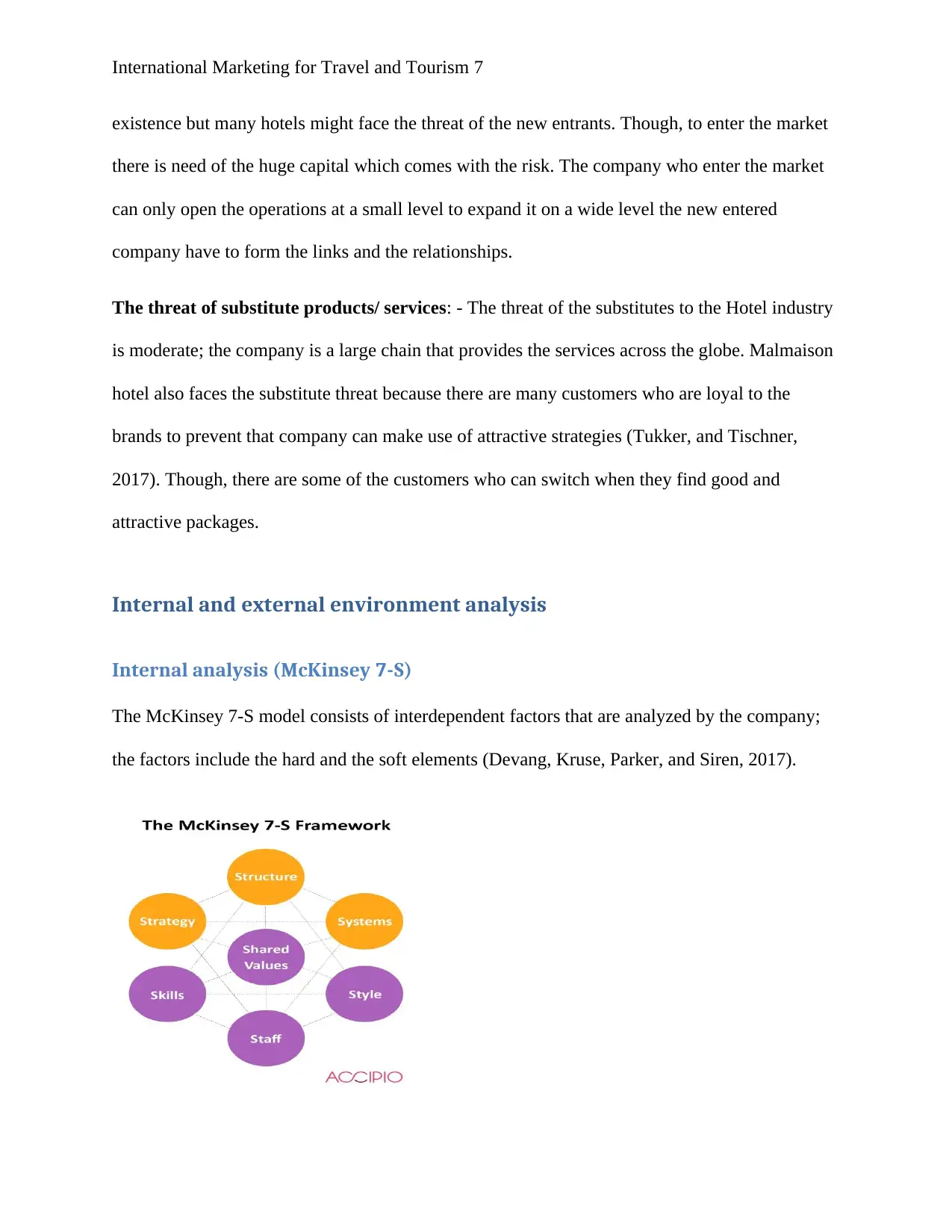
International Marketing for Travel and Tourism 7
existence but many hotels might face the threat of the new entrants. Though, to enter the market
there is need of the huge capital which comes with the risk. The company who enter the market
can only open the operations at a small level to expand it on a wide level the new entered
company have to form the links and the relationships.
The threat of substitute products/ services: - The threat of the substitutes to the Hotel industry
is moderate; the company is a large chain that provides the services across the globe. Malmaison
hotel also faces the substitute threat because there are many customers who are loyal to the
brands to prevent that company can make use of attractive strategies (Tukker, and Tischner,
2017). Though, there are some of the customers who can switch when they find good and
attractive packages.
Internal and external environment analysis
Internal analysis (McKinsey 7-S)
The McKinsey 7-S model consists of interdependent factors that are analyzed by the company;
the factors include the hard and the soft elements (Devang, Kruse, Parker, and Siren, 2017).
existence but many hotels might face the threat of the new entrants. Though, to enter the market
there is need of the huge capital which comes with the risk. The company who enter the market
can only open the operations at a small level to expand it on a wide level the new entered
company have to form the links and the relationships.
The threat of substitute products/ services: - The threat of the substitutes to the Hotel industry
is moderate; the company is a large chain that provides the services across the globe. Malmaison
hotel also faces the substitute threat because there are many customers who are loyal to the
brands to prevent that company can make use of attractive strategies (Tukker, and Tischner,
2017). Though, there are some of the customers who can switch when they find good and
attractive packages.
Internal and external environment analysis
Internal analysis (McKinsey 7-S)
The McKinsey 7-S model consists of interdependent factors that are analyzed by the company;
the factors include the hard and the soft elements (Devang, Kruse, Parker, and Siren, 2017).
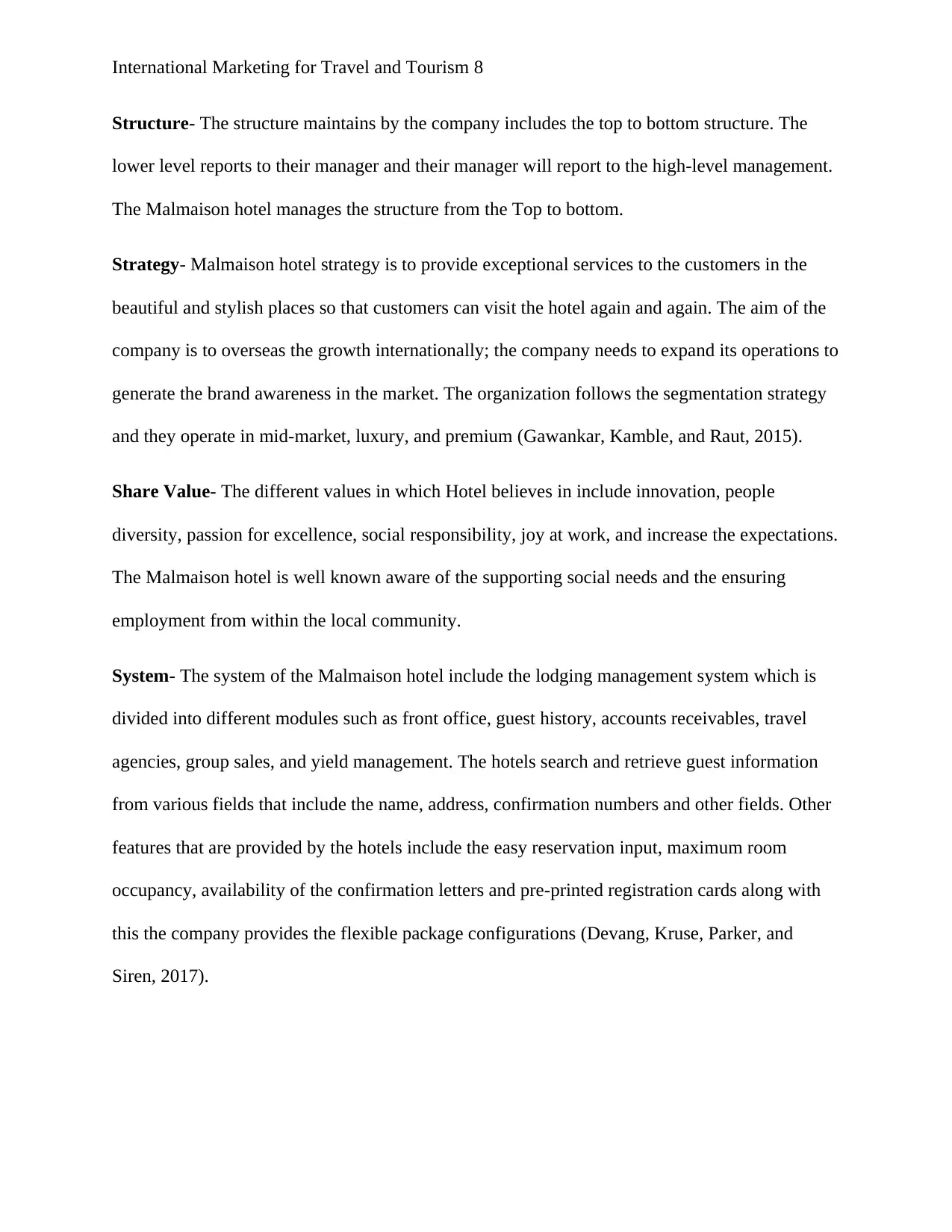
International Marketing for Travel and Tourism 8
Structure- The structure maintains by the company includes the top to bottom structure. The
lower level reports to their manager and their manager will report to the high-level management.
The Malmaison hotel manages the structure from the Top to bottom.
Strategy- Malmaison hotel strategy is to provide exceptional services to the customers in the
beautiful and stylish places so that customers can visit the hotel again and again. The aim of the
company is to overseas the growth internationally; the company needs to expand its operations to
generate the brand awareness in the market. The organization follows the segmentation strategy
and they operate in mid-market, luxury, and premium (Gawankar, Kamble, and Raut, 2015).
Share Value- The different values in which Hotel believes in include innovation, people
diversity, passion for excellence, social responsibility, joy at work, and increase the expectations.
The Malmaison hotel is well known aware of the supporting social needs and the ensuring
employment from within the local community.
System- The system of the Malmaison hotel include the lodging management system which is
divided into different modules such as front office, guest history, accounts receivables, travel
agencies, group sales, and yield management. The hotels search and retrieve guest information
from various fields that include the name, address, confirmation numbers and other fields. Other
features that are provided by the hotels include the easy reservation input, maximum room
occupancy, availability of the confirmation letters and pre-printed registration cards along with
this the company provides the flexible package configurations (Devang, Kruse, Parker, and
Siren, 2017).
Structure- The structure maintains by the company includes the top to bottom structure. The
lower level reports to their manager and their manager will report to the high-level management.
The Malmaison hotel manages the structure from the Top to bottom.
Strategy- Malmaison hotel strategy is to provide exceptional services to the customers in the
beautiful and stylish places so that customers can visit the hotel again and again. The aim of the
company is to overseas the growth internationally; the company needs to expand its operations to
generate the brand awareness in the market. The organization follows the segmentation strategy
and they operate in mid-market, luxury, and premium (Gawankar, Kamble, and Raut, 2015).
Share Value- The different values in which Hotel believes in include innovation, people
diversity, passion for excellence, social responsibility, joy at work, and increase the expectations.
The Malmaison hotel is well known aware of the supporting social needs and the ensuring
employment from within the local community.
System- The system of the Malmaison hotel include the lodging management system which is
divided into different modules such as front office, guest history, accounts receivables, travel
agencies, group sales, and yield management. The hotels search and retrieve guest information
from various fields that include the name, address, confirmation numbers and other fields. Other
features that are provided by the hotels include the easy reservation input, maximum room
occupancy, availability of the confirmation letters and pre-printed registration cards along with
this the company provides the flexible package configurations (Devang, Kruse, Parker, and
Siren, 2017).
⊘ This is a preview!⊘
Do you want full access?
Subscribe today to unlock all pages.

Trusted by 1+ million students worldwide
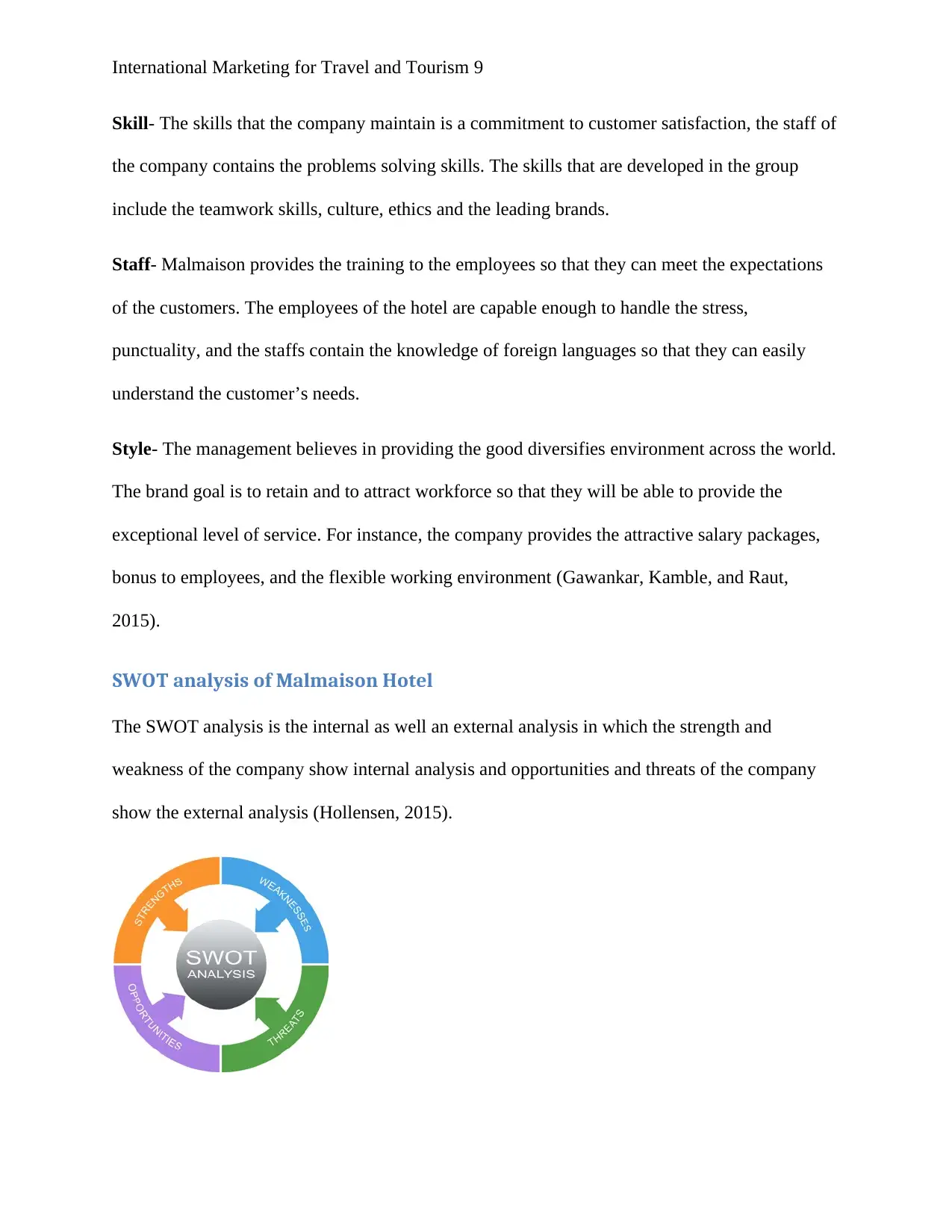
International Marketing for Travel and Tourism 9
Skill- The skills that the company maintain is a commitment to customer satisfaction, the staff of
the company contains the problems solving skills. The skills that are developed in the group
include the teamwork skills, culture, ethics and the leading brands.
Staff- Malmaison provides the training to the employees so that they can meet the expectations
of the customers. The employees of the hotel are capable enough to handle the stress,
punctuality, and the staffs contain the knowledge of foreign languages so that they can easily
understand the customer’s needs.
Style- The management believes in providing the good diversifies environment across the world.
The brand goal is to retain and to attract workforce so that they will be able to provide the
exceptional level of service. For instance, the company provides the attractive salary packages,
bonus to employees, and the flexible working environment (Gawankar, Kamble, and Raut,
2015).
SWOT analysis of Malmaison Hotel
The SWOT analysis is the internal as well an external analysis in which the strength and
weakness of the company show internal analysis and opportunities and threats of the company
show the external analysis (Hollensen, 2015).
Skill- The skills that the company maintain is a commitment to customer satisfaction, the staff of
the company contains the problems solving skills. The skills that are developed in the group
include the teamwork skills, culture, ethics and the leading brands.
Staff- Malmaison provides the training to the employees so that they can meet the expectations
of the customers. The employees of the hotel are capable enough to handle the stress,
punctuality, and the staffs contain the knowledge of foreign languages so that they can easily
understand the customer’s needs.
Style- The management believes in providing the good diversifies environment across the world.
The brand goal is to retain and to attract workforce so that they will be able to provide the
exceptional level of service. For instance, the company provides the attractive salary packages,
bonus to employees, and the flexible working environment (Gawankar, Kamble, and Raut,
2015).
SWOT analysis of Malmaison Hotel
The SWOT analysis is the internal as well an external analysis in which the strength and
weakness of the company show internal analysis and opportunities and threats of the company
show the external analysis (Hollensen, 2015).
Paraphrase This Document
Need a fresh take? Get an instant paraphrase of this document with our AI Paraphraser
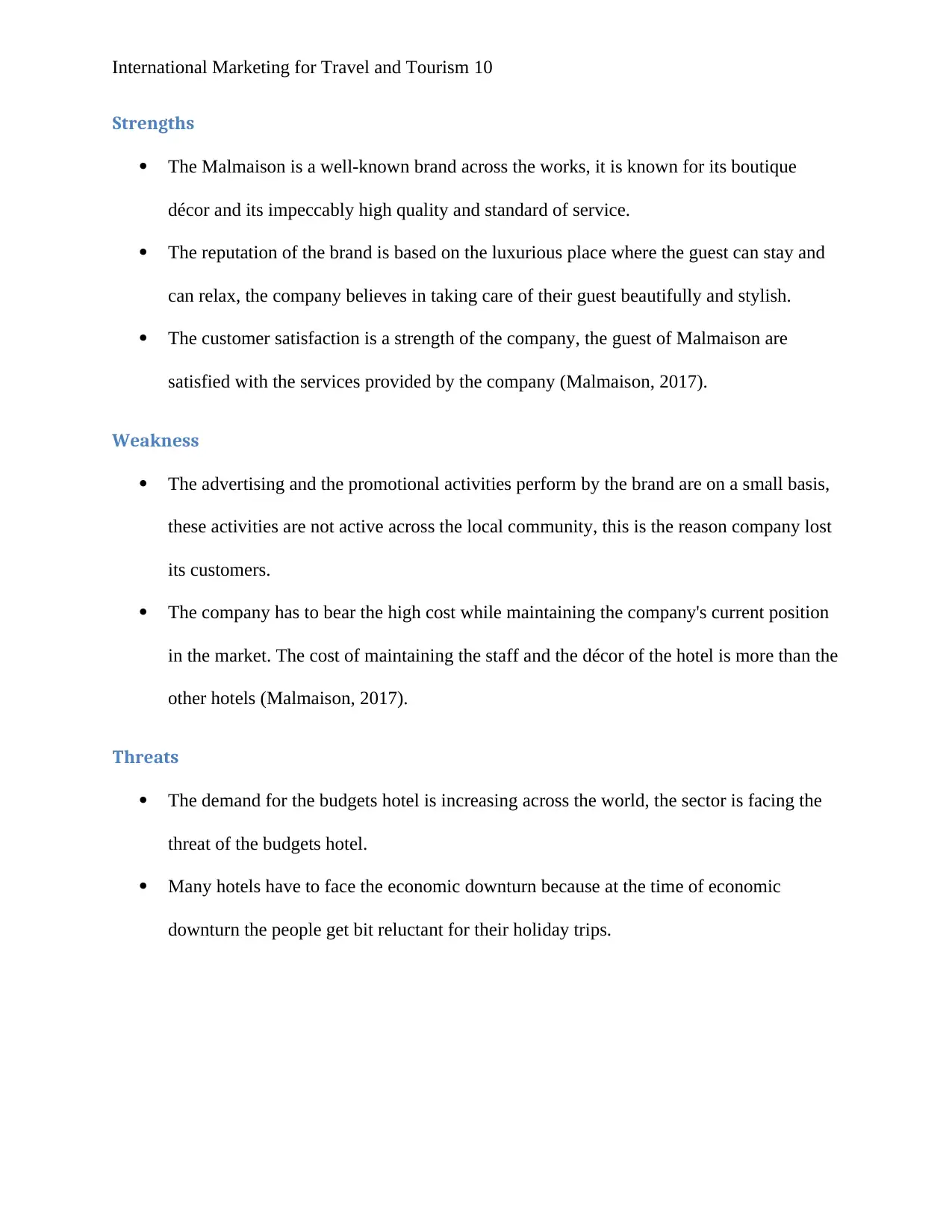
International Marketing for Travel and Tourism 10
Strengths
The Malmaison is a well-known brand across the works, it is known for its boutique
décor and its impeccably high quality and standard of service.
The reputation of the brand is based on the luxurious place where the guest can stay and
can relax, the company believes in taking care of their guest beautifully and stylish.
The customer satisfaction is a strength of the company, the guest of Malmaison are
satisfied with the services provided by the company (Malmaison, 2017).
Weakness
The advertising and the promotional activities perform by the brand are on a small basis,
these activities are not active across the local community, this is the reason company lost
its customers.
The company has to bear the high cost while maintaining the company's current position
in the market. The cost of maintaining the staff and the décor of the hotel is more than the
other hotels (Malmaison, 2017).
Threats
The demand for the budgets hotel is increasing across the world, the sector is facing the
threat of the budgets hotel.
Many hotels have to face the economic downturn because at the time of economic
downturn the people get bit reluctant for their holiday trips.
Strengths
The Malmaison is a well-known brand across the works, it is known for its boutique
décor and its impeccably high quality and standard of service.
The reputation of the brand is based on the luxurious place where the guest can stay and
can relax, the company believes in taking care of their guest beautifully and stylish.
The customer satisfaction is a strength of the company, the guest of Malmaison are
satisfied with the services provided by the company (Malmaison, 2017).
Weakness
The advertising and the promotional activities perform by the brand are on a small basis,
these activities are not active across the local community, this is the reason company lost
its customers.
The company has to bear the high cost while maintaining the company's current position
in the market. The cost of maintaining the staff and the décor of the hotel is more than the
other hotels (Malmaison, 2017).
Threats
The demand for the budgets hotel is increasing across the world, the sector is facing the
threat of the budgets hotel.
Many hotels have to face the economic downturn because at the time of economic
downturn the people get bit reluctant for their holiday trips.
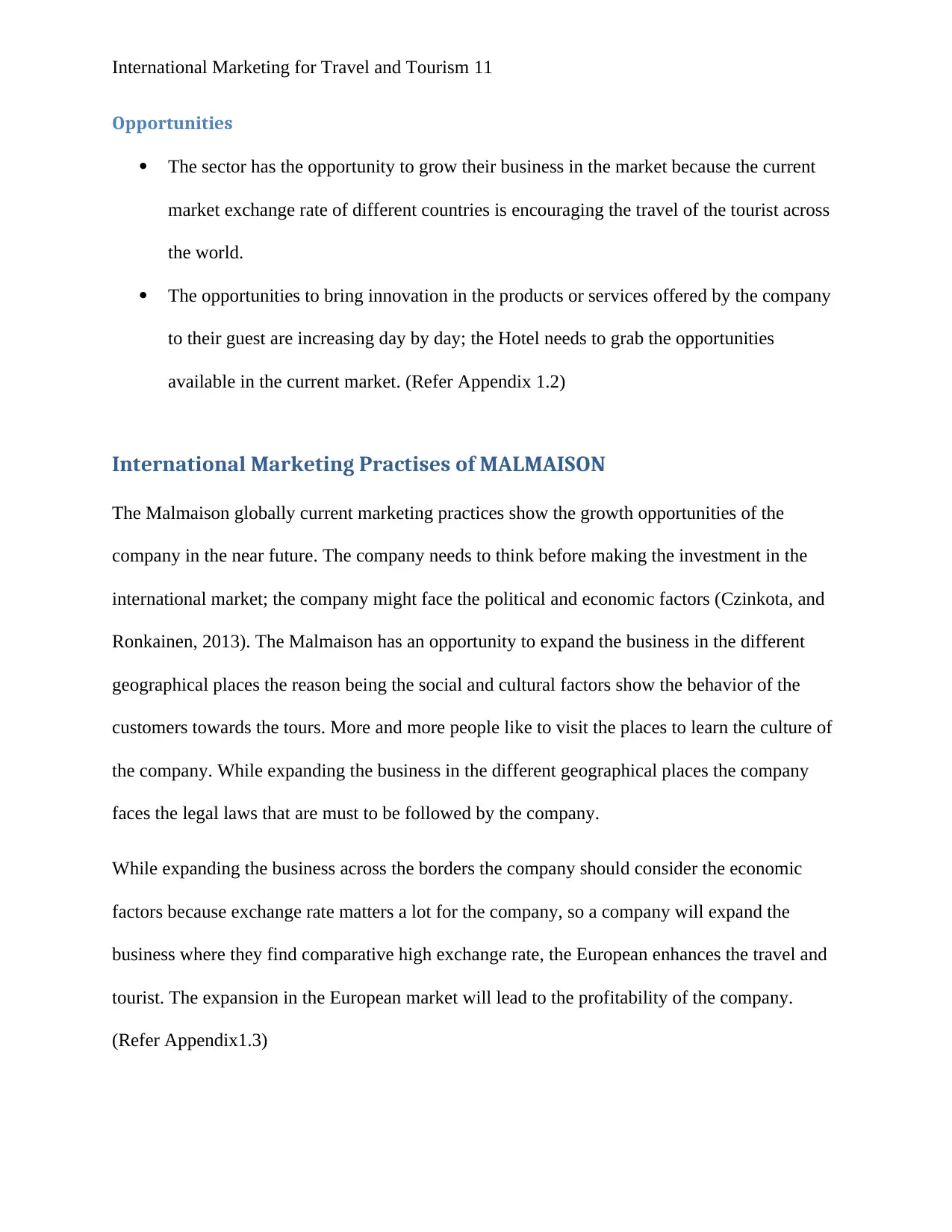
International Marketing for Travel and Tourism 11
Opportunities
The sector has the opportunity to grow their business in the market because the current
market exchange rate of different countries is encouraging the travel of the tourist across
the world.
The opportunities to bring innovation in the products or services offered by the company
to their guest are increasing day by day; the Hotel needs to grab the opportunities
available in the current market. (Refer Appendix 1.2)
International Marketing Practises of MALMAISON
The Malmaison globally current marketing practices show the growth opportunities of the
company in the near future. The company needs to think before making the investment in the
international market; the company might face the political and economic factors (Czinkota, and
Ronkainen, 2013). The Malmaison has an opportunity to expand the business in the different
geographical places the reason being the social and cultural factors show the behavior of the
customers towards the tours. More and more people like to visit the places to learn the culture of
the company. While expanding the business in the different geographical places the company
faces the legal laws that are must to be followed by the company.
While expanding the business across the borders the company should consider the economic
factors because exchange rate matters a lot for the company, so a company will expand the
business where they find comparative high exchange rate, the European enhances the travel and
tourist. The expansion in the European market will lead to the profitability of the company.
(Refer Appendix1.3)
Opportunities
The sector has the opportunity to grow their business in the market because the current
market exchange rate of different countries is encouraging the travel of the tourist across
the world.
The opportunities to bring innovation in the products or services offered by the company
to their guest are increasing day by day; the Hotel needs to grab the opportunities
available in the current market. (Refer Appendix 1.2)
International Marketing Practises of MALMAISON
The Malmaison globally current marketing practices show the growth opportunities of the
company in the near future. The company needs to think before making the investment in the
international market; the company might face the political and economic factors (Czinkota, and
Ronkainen, 2013). The Malmaison has an opportunity to expand the business in the different
geographical places the reason being the social and cultural factors show the behavior of the
customers towards the tours. More and more people like to visit the places to learn the culture of
the company. While expanding the business in the different geographical places the company
faces the legal laws that are must to be followed by the company.
While expanding the business across the borders the company should consider the economic
factors because exchange rate matters a lot for the company, so a company will expand the
business where they find comparative high exchange rate, the European enhances the travel and
tourist. The expansion in the European market will lead to the profitability of the company.
(Refer Appendix1.3)
⊘ This is a preview!⊘
Do you want full access?
Subscribe today to unlock all pages.

Trusted by 1+ million students worldwide
1 out of 31
Related Documents
Your All-in-One AI-Powered Toolkit for Academic Success.
+13062052269
info@desklib.com
Available 24*7 on WhatsApp / Email
![[object Object]](/_next/static/media/star-bottom.7253800d.svg)
Unlock your academic potential
Copyright © 2020–2025 A2Z Services. All Rights Reserved. Developed and managed by ZUCOL.





